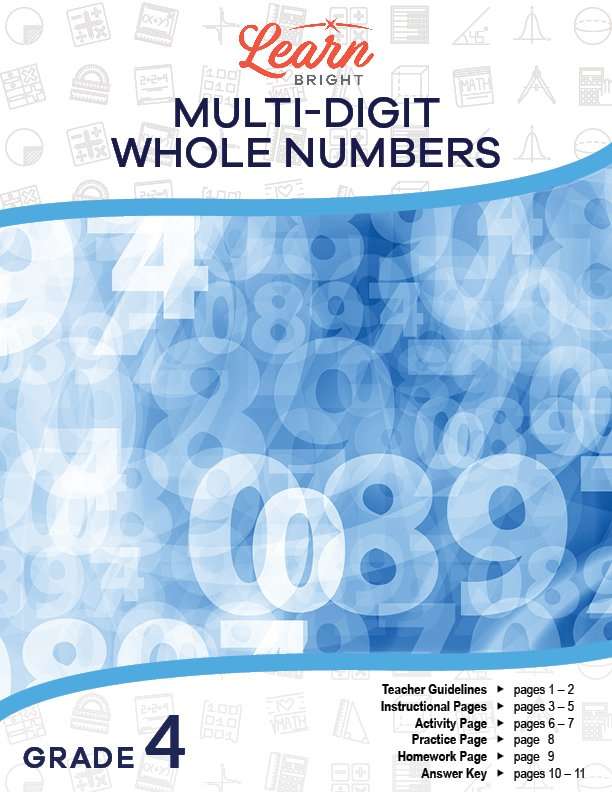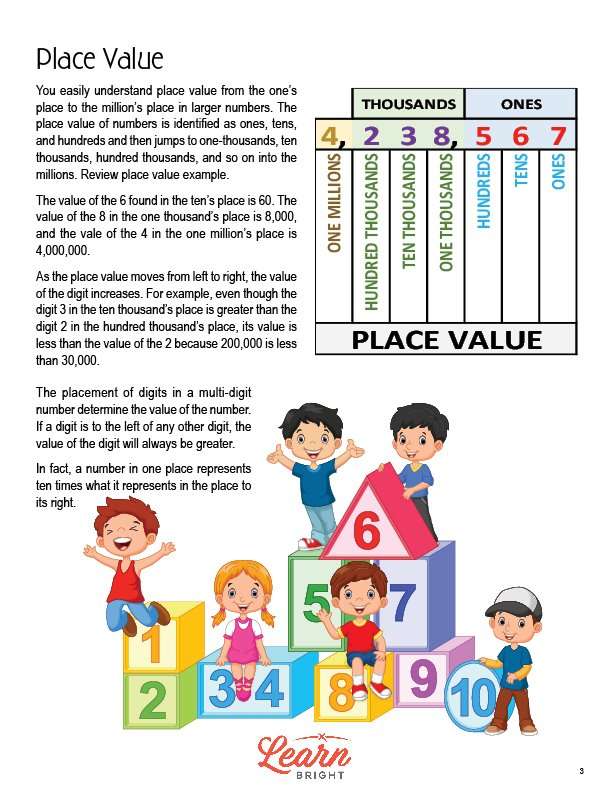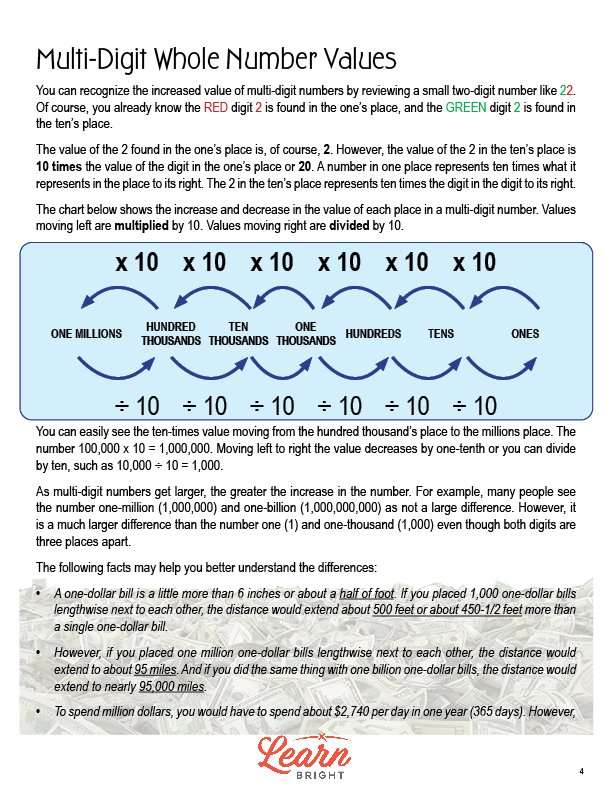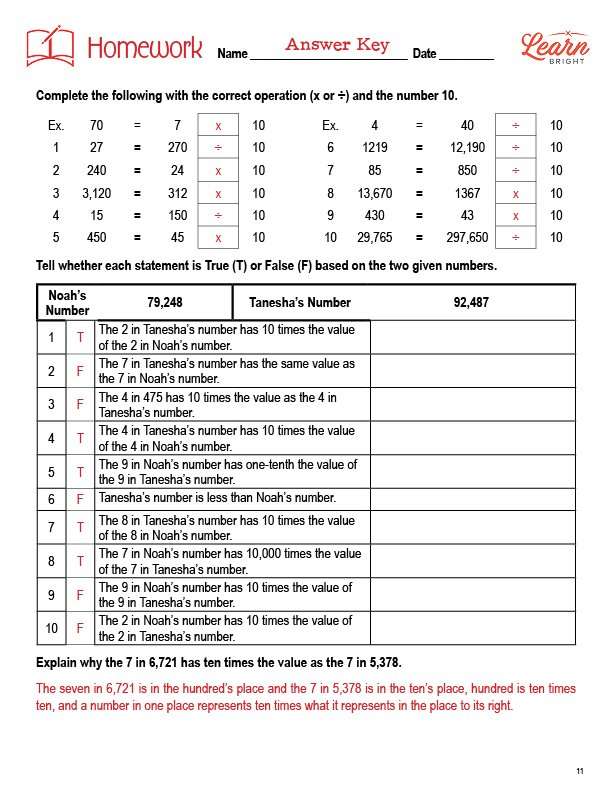Description
What our Multi-Digit Whole Numbers lesson plan includes
Lesson Objectives and Overview: Multi-Digit Whole Numbers teaches students how to read and understand multi-digit whole numbers. As a part of the lesson, students learn about place value. At the end of the lesson, students will be able to recognize that in a multi-digit whole number, a digit in one place represents ten times what it represents in the place to its right. This lesson is for students in 4th grade.
Classroom Procedure
Every lesson plan provides you with a classroom procedure page that outlines a step-by-step guide to follow. You do not have to follow the guide exactly. The guide helps you organize the lesson and details when to hand out worksheets. It also lists information in the blue box that you might find useful. You will find the lesson objectives, state standards, and number of class sessions the lesson should take to complete in this area. In addition, it describes the supplies you will need as well as what and how you need to prepare beforehand.
Options for Lesson
Included with this lesson is an “Options for Lesson” section that lists a number of suggestions for activities to add to the lesson or substitutions for the ones already in the lesson. One optional addition to this lesson is to have your students create a poster to show the “times-ten” concept. You could also conduct a “Multi-Digit Bee” where you announce a number and a specific digit and the student mentally says a number with the same digit but with its value ten times greater.Finally, you could have your students compare phone numbers and discover digits that are ten times or one-tenth of a digit to the left of right respectively.
Teacher Notes
The teacher notes page includes a paragraph with additional guidelines and things to think about as you begin to plan your lesson. This page also includes lines that you can use to add your own notes as you’re preparing for this lesson.
MULTI-DIGIT WHOLE NUMBERS LESSON PLAN CONTENT PAGES
Place Value
The Multi-Digit Whole Numbers lesson plan includes three content pages. The place value of numbers is identified as ones, tens, and hundreds, followed by one-thousands, ten thousands, hundred thousands, and so on.
When we look at the number 4,238,567, we can see that the 6 is in the tens place and its value is therefore 60. The 8 is in the thousands place for a value of 8,000, and the 4 is in the millions place for a value of 4,000,000. As you move from left to right, the value decreases. The digit 3 is larger than the digit 2, but the 3 is in the ten thousands place and the 2 is in the hundred thousands place. The value of the 3 is less than the value of the 2 because 30,000 is less than 200,000.
The placement of the digits in a multi-digit number tells you the value of the number. A digit to the left of any other digit will always have a great value. A number in one place represents ten times what it represents in the place to its right.
Multi-Digit Whole Number Values
To understand the increased value of multi-digit numbers, we can look at an example: 22. The 2 in the ones place is worth less than the 2 in the tens place, even though they’re the same digit. The value of the 2 in the ones place is 2, while the value of the 2 in the tens place is 20. The 2 in the tens place has a value ten times greater than the 2 in the ones place.
When looking at place value, values moving left are multiplied by 10 while values moving right are divided by 10. For example, to move from the hundred thousands place to the millions place, we multiply by 10: 100,000 x = 1,000,000. We do the opposite when moving right: 1,000,000 ÷ 10 = 100,000.
It’s important to understand that, even though you multiply by the same number to move from one place to the next, the value increases by a greater amount. For example, the difference number one-million (1,000,000) and one-billion (1,000,000,000) is much larger than the difference between the number one (1) and one-thousand (1,000), even though both digits are three places apart.
Let’s look at an example problem: Thomas wrote the number 24,185. His friend Denise also wrote a five-digit number that has only one 4 in it. The 4 in Denise’s number is worth 10 times as much as the 3 in Thomas’ number. What three numbers could Denise have written?
To solve this, we need to write five-digit numbers with a 4 in the ten thousands place, like 45,329, 40,896, and 42,173. In each of these numbers, the 4 is in the ten thousands place. Its value is ten times the value of the digit 4 in Thomas’ number.
Always remember that the value of digits moving from right to left in a number is ten times and the value of digits moving from left to right in one-tenth, or you must divide by 10.
MULTI-DIGIT WHOLE NUMBERS LESSON PLAN WORKSHEETS
The Multi-Digit Whole Numbers lesson plan includes three worksheets: an activity worksheet, a practice worksheet, and a homework assignment. You can refer to the guide on the classroom procedure page to determine when to hand out each worksheet.
DIGITS ACTIVITY WORKSHEET
Students will work with a partner to complete the activity worksheet. Each pair will first cut out the digits on the worksheet. To play the game, Player 1 will first create a 3 to 7-digit number. Next, Player 2 will create a 3 to 7-digit number using one of the same digits (it must be 10 times the value of the same digit in Player 1’s number). The two players take turns listing numbers on the worksheet, circling the digits that are 10 times and one-tenth the value in the numbers.
MOUNTAINS PRACTICE WORKSHEET
For the practice worksheet, students will use the provided chart of mountain heights to answer true or false and multiple choice questions.
MULTI-DIGIT WHOLE NUMBERS HOMEWORK ASSIGNMENT
The homework assignment asks students to first complete equations with the correct operation (x or ÷). Next, they will tell whether different statements are true or false based on the given numbers and information. Finally, they will explain why the 7 in 6,721 has ten times the value as the 7 in 5,378.
Worksheet Answer Keys
This lesson plan includes answer keys for the practice worksheet and the homework assignment. If you choose to administer the lesson pages to your students via PDF, you will need to save a new file that omits these pages. Otherwise, you can simply print out the applicable pages and keep these as reference for yourself when grading assignments.










